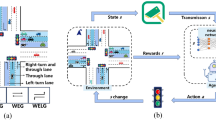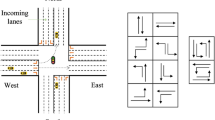Abstract
Traffic signal control in cities today is not well optimized according to the feedback received from the real world. And such an inefficiency in traffic signal control results in people’s waste of time in commuting, road rage in the traffic jam, and high cost for city operation. Recently, deep reinforcement learning (DRL) approaches shed lights to better optimize traffic signal plans according to the feedback received from the environment. Most of these methods are evaluated in a simulated environment, but can not be applied to intersections in the real world directly, as the training of DRL relies on a great amount of samples and takes a long time to converge. In this paper, we propose a batch learning framework where the targeted transfer reinforcement learning (TTRL-B) is introduced to speed up learning. Specifically, a separate unsupervised method is designed to measure the similarities of traffic conditions to select the suitable source intersection for transfer. The proposed framework allows batch learning and this is the first work to consider the impact of slow learning in RL on real-world applications. Experiments on real traffic data demonstrate that our model accelerates learning with good performance.
N. Xu—Work done during an internship at Tianrang.
Access this chapter
Tax calculation will be finalised at checkout
Purchases are for personal use only
Similar content being viewed by others
Notes
References
Bakker, B., Whiteson, S., Kester, L., Groen, F.C.: Traffic light control by multiagent reinforcement learning systems. In: Babuška, R., Groen, F.C.A. (eds.) Interactive Collaborative Information Systems. SCI, vol. 281, pp. 475–510. Springer, Heidelberg (2010). https://doi.org/10.1007/978-3-642-11688-9_18
Cools, S.B., Gershenson, C., D’Hooghe, B.: Self-organizing traffic lights: a realistic simulation. In: Prokopenko, M. (ed.) Advances in Applied Self-Organizing Systems. AI&KP, pp. 45–55. Springer, London (2013). https://doi.org/10.1007/978-1-4471-5113-5_3
Du, Y., Gabriel, V., Irwin, J., Taylor, M.E.: Initial progress in transfer for deep reinforcement learning algorithms. In: Proceedings of Deep Reinforcement Learning: Frontiers and Challenges Workshop, New York City, NY, USA (2016)
Gao, J., Shen, Y., Liu, J., Ito, M., Shiratori, N.: Adaptive traffic signal control: deep reinforcement learning algorithm with experience replay and target network. arXiv preprint arXiv:1705.02755 (2017)
Hinton, G., Vinyals, O., Dean, J.: Distilling the knowledge in a neural network. arXiv preprint arXiv:1503.02531 (2015)
Hochreiter, S., Schmidhuber, J.: Long short-term memory. Neural Comput. 9(8), 1735–1780 (1997)
Hunt, P., Robertson, D., Bretherton, R., Winton, R.: Scoot - a traffic responsive method of coordinating signals. Technical report (1981)
Liu, M., Deng, J., Xu, M., Zhang, X., Wang, W.: Cooperative deep reinforcement learning for traffic signal control (2017)
Lowrie, P.: SCATS, Sydney co-ordinated adaptive traffic system: a traffic responsive method of controlling urban traffic (1990)
Lu, W., Hou, J., Yan, Y., Zhang, M., Du, X., Moscibroda, T.: MSQL: efficient similarity search in metric spaces using SQL. The VLDB J.-Int. J. Very Large Data Bases 26(6), 829–854 (2017)
Miller, A.J.: Settings for fixed-cycle traffic signals. J. Oper. Res. Soc. 14(4), 373–386 (1963)
Mnih, V., et al.: Human-level control through deep reinforcement learning. Nature 518(7540), 529 (2015)
Mousavi, S.S., Schukat, M., Howley, E.: Traffic light control using deep policy-gradient and value-function-based reinforcement learning. Intell. Transp. Syst. (ITS) 11(7), 417–423 (2017)
Pan, S.J., Yang, Q., et al.: A survey on transfer learning. IEEE Trans. Knowl. Data Eng. 22(10), 1345–1359 (2010)
Parisotto, E., Ba, J.L., Salakhutdinov, R.: Actor-mimic: deep multitask and transfer reinforcement learning. arXiv preprint arXiv:1511.06342 (2015)
Reynolds, D.: Gaussian mixture models. In: Li, S.Z., Jain, A. (eds.) Encyclopedia of Biometrics, pp. 827–832. Springer, Boston (2015). https://doi.org/10.1007/978-0-387-73003-5_196
Roess, R.P., Prassas, E.S., McShane, W.R.: Traffic Engineering. Pearson/Prentice Hall, Upper Saddle River (2004)
Rusu, A.A., et al.: Policy distillation. arXiv preprint arXiv:1511.06295 (2015)
Taylor, M.E., Stone, P.: Transfer learning for reinforcement learning domains: a survey. J. Mach. Learn. Res. 10(July), 1633–1685 (2009)
Tessler, C., Givony, S., Zahavy, T., Mankowitz, D.J., Mannor, S.: A deep hierarchical approach to lifelong learning in minecraft. In: AAAI, vol. 3, p. 6 (2017)
Thrun, S., Pratt, L.: Learning to Learn. Springer, New York (2012). https://doi.org/10.1007/978-1-4615-5529-2
Wang, J.X., et al.: Learning to reinforcement learn. arXiv preprint arXiv:1611.05763 (2016)
Webster, F.V.: Traffic signal settings. Technical report (1958)
Wei, H., Zheng, G., Yao, H., Li, Z.: IntelliLight: a reinforcement learning approach for intelligent traffic light control. In: ACM SIGKDD International Conference on Knowledge Discovery & Data Mining (KDD), pp. 2496–2505 (2018)
Wiering, M.: Multi-agent reinforcement learning for traffic light control. In: Machine Learning: Proceedings of the Seventeenth International Conference (ICML 2000), pp. 1151–1158 (2000)
Zhang, Z., Huang, K., Tan, T.: Comparison of similarity measures for trajectory clustering in outdoor surveillance scenes. In: 18th International Conference on Pattern Recognition, ICPR 2006, vol. 3, pp. 1135–1138. IEEE (2006)
Author information
Authors and Affiliations
Corresponding author
Editor information
Editors and Affiliations
Rights and permissions
Copyright information
© 2019 Springer Nature Switzerland AG
About this paper
Cite this paper
Xu, N., Zheng, G., Xu, K., Zhu, Y., Li, Z. (2019). Targeted Knowledge Transfer for Learning Traffic Signal Plans. In: Yang, Q., Zhou, ZH., Gong, Z., Zhang, ML., Huang, SJ. (eds) Advances in Knowledge Discovery and Data Mining. PAKDD 2019. Lecture Notes in Computer Science(), vol 11440. Springer, Cham. https://doi.org/10.1007/978-3-030-16145-3_14
Download citation
DOI: https://doi.org/10.1007/978-3-030-16145-3_14
Published:
Publisher Name: Springer, Cham
Print ISBN: 978-3-030-16144-6
Online ISBN: 978-3-030-16145-3
eBook Packages: Computer ScienceComputer Science (R0)




